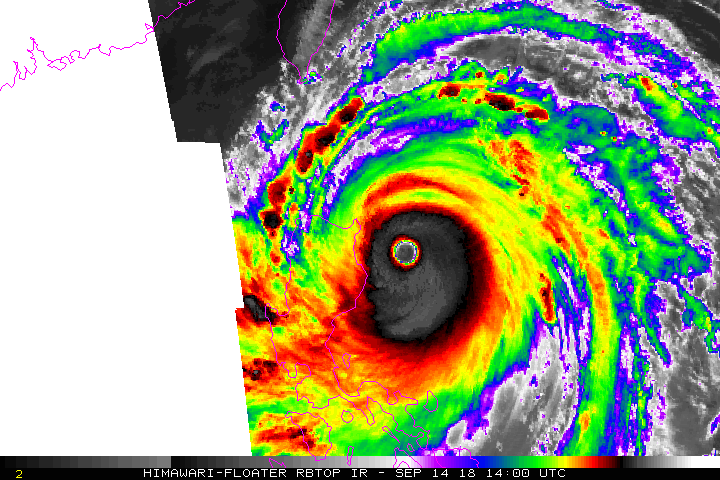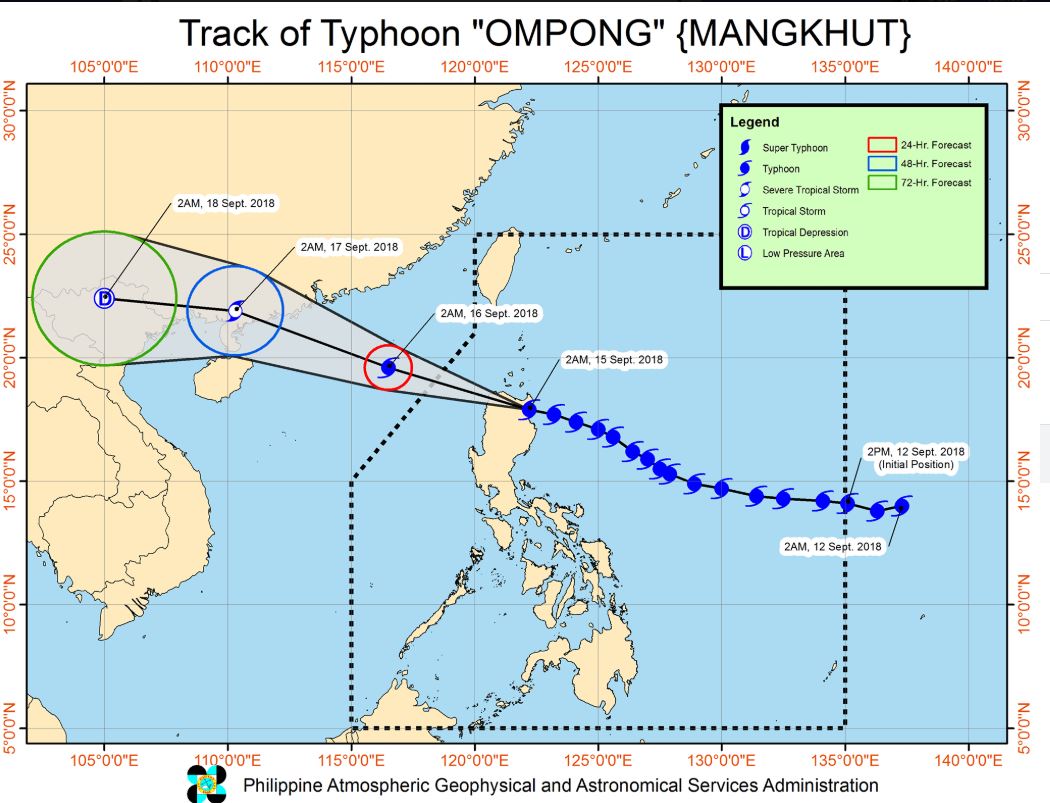Typhoon Ompong heads toward Apayao, Ilocos Norte | ABS-CBN
ADVERTISEMENT

Welcome, Kapamilya! We use cookies to improve your browsing experience. Continuing to use this site means you agree to our use of cookies. Tell me more!
Typhoon Ompong heads toward Apayao, Ilocos Norte
ABS-CBN News
Published Sep 15, 2018 06:20 AM PHT
|
Updated Sep 15, 2018 06:15 PM PHT
MANILA - Typhoon Ompong (International name Mangkhut) slammed into the northern Philippines on Saturday with violent winds and torrential rains, as authorities warned millions in its path of potentially heavy destruction.
The massive storm, which forecasters have called the strongest typhoon this year, blew in windows, hurled debris and knocked out power lines when it made landfall in the pre-dawn darkness near Baggao, Cagayan.
MANILA - Typhoon Ompong (International name Mangkhut) slammed into the northern Philippines on Saturday with violent winds and torrential rains, as authorities warned millions in its path of potentially heavy destruction.
The massive storm, which forecasters have called the strongest typhoon this year, blew in windows, hurled debris and knocked out power lines when it made landfall in the pre-dawn darkness near Baggao, Cagayan.
Currently packing 200 kilometers per hour (kph) winds and gusts of up to 330 kph, it headed west at a speed of 35 kph towards the provinces of Apayao and Ilocos Norte.
Currently packing 200 kilometers per hour (kph) winds and gusts of up to 330 kph, it headed west at a speed of 35 kph towards the provinces of Apayao and Ilocos Norte.
State weather bureau PAGASA has raised the following tropical cyclone warning signals over the following areas:
State weather bureau PAGASA has raised the following tropical cyclone warning signals over the following areas:
SIGNAL NO. 4
- Ilocos Norte
- Cagayan
- Northern Isabela
- Apayao
- Abra
- Kalinga
- Babuyan Group of Islands
- Ilocos Norte
- Cagayan
- Northern Isabela
- Apayao
- Abra
- Kalinga
- Babuyan Group of Islands
SIGNAL NO. 3
- Batanes
- Southern Isabela
- Ilocos Sur
- La Union
- Mountain Province
- Benguet
- Ifugao
- Nueva Vizcaya
- Quirino
- Northern Aurora
- Batanes
- Southern Isabela
- Ilocos Sur
- La Union
- Mountain Province
- Benguet
- Ifugao
- Nueva Vizcaya
- Quirino
- Northern Aurora
SIGNAL NO. 2
- Pangasinan
- Tarlac
- Nueva Ecija
- Southern Aurora
- Zambales
- Pampanga
- Bulacan
- Northern Quezon, including Polillo Island
- Pangasinan
- Tarlac
- Nueva Ecija
- Southern Aurora
- Zambales
- Pampanga
- Bulacan
- Northern Quezon, including Polillo Island
SIGNAL NO. 1
- Bataan
- Rizal
- Metro Manila
- Cavite
- Batangas
- Laguna
- Rest of Quezon
- Lubang Island
- Marinduque
- Camarines Norte
- Bataan
- Rizal
- Metro Manila
- Cavite
- Batangas
- Laguna
- Rest of Quezon
- Lubang Island
- Marinduque
- Camarines Norte
'STAY INDOORS'
"As much as possible, stay indoors," Chris Perez, a PAGASA forecaster warned. Around four million people are in the path of the storm.
"As much as possible, stay indoors," Chris Perez, a PAGASA forecaster warned. Around four million people are in the path of the storm.
ADVERTISEMENT
An average of 20 typhoons and storms lash the Philippines each year, killing hundreds of people and leaving millions in near-perpetual poverty.
An average of 20 typhoons and storms lash the Philippines each year, killing hundreds of people and leaving millions in near-perpetual poverty.
Thousands of people fled their homes in high-risk areas ahead of the storm's arrival because of major flooding and landslide risks.
Thousands of people fled their homes in high-risk areas ahead of the storm's arrival because of major flooding and landslide risks.
Authorities hiked the storm alert on Friday to its second highest level in northern Luzon provinces and mobilised rescue teams.
Authorities hiked the storm alert on Friday to its second highest level in northern Luzon provinces and mobilised rescue teams.
The elevated warning level carried risks of "very heavy" damage to communities hit by the typhoon and a storm surge that was forecast to hit six meters in some areas, the weather service said.
The elevated warning level carried risks of "very heavy" damage to communities hit by the typhoon and a storm surge that was forecast to hit six meters in some areas, the weather service said.
Residents started lashing down their roofs and gathering supplies days before the arrival of the storm that forecasters said is the most powerful of 2018.
Residents started lashing down their roofs and gathering supplies days before the arrival of the storm that forecasters said is the most powerful of 2018.
ADVERTISEMENT
'TERRIFIED'
"Among all the typhoons this year, this one (Mangkhut) is the strongest," Japan Meteorological Agency forecaster Hiroshi Ishihara told AFP on Friday.
"Among all the typhoons this year, this one (Mangkhut) is the strongest," Japan Meteorological Agency forecaster Hiroshi Ishihara told AFP on Friday.
"This is a violent typhoon. It has the strongest sustained wind (among the typhoons of this year)", he added.
"This is a violent typhoon. It has the strongest sustained wind (among the typhoons of this year)", he added.
After blasting the Philippines, Mangkhut is predicted to hurtle towards China's heavily populated southern coast this weekend.
After blasting the Philippines, Mangkhut is predicted to hurtle towards China's heavily populated southern coast this weekend.
"They (authorities) said this typhoon is twice as strong as the last typhoon, that's why we are terrified," Myrna Parallag, 53, told AFP after fleeing her home in the northern Philippines.
"They (authorities) said this typhoon is twice as strong as the last typhoon, that's why we are terrified," Myrna Parallag, 53, told AFP after fleeing her home in the northern Philippines.
"We learned our lesson last time. The water reached our roof," she said, referring to when her family rode out a typhoon at home in 2016.
"We learned our lesson last time. The water reached our roof," she said, referring to when her family rode out a typhoon at home in 2016.
ADVERTISEMENT
The country's deadliest on record is Super Typhoon Haiyan, which left more than 7,350 people dead or missing across the central Philippines in November 2013.
The country's deadliest on record is Super Typhoon Haiyan, which left more than 7,350 people dead or missing across the central Philippines in November 2013.
Poor communities reliant on fishing are some of the most vulnerable to fierce typhoon winds and the storm surges that pound the coast.
Poor communities reliant on fishing are some of the most vulnerable to fierce typhoon winds and the storm surges that pound the coast.
"The rains will be strong and the winds are no joke... We may have a storm surge that could reach four storeys high," Michael Conag, a spokesman for local civil defence authorities, told AFP.
"The rains will be strong and the winds are no joke... We may have a storm surge that could reach four storeys high," Michael Conag, a spokesman for local civil defence authorities, told AFP.
The storm is not forecast to directly hit Hong Kong, though it will feel Mangkhut's wind and rain through Sunday.
The storm is not forecast to directly hit Hong Kong, though it will feel Mangkhut's wind and rain through Sunday.
However, the Hong Kong Observatory warned that the massive typhoon will pose a "severe threat" to China's southern coast before moving on to northern Vietnam. - with a report from Agence France-Presse
However, the Hong Kong Observatory warned that the massive typhoon will pose a "severe threat" to China's southern coast before moving on to northern Vietnam. - with a report from Agence France-Presse
ADVERTISEMENT
Visit the ABS-CBN Weather Center for the latest weather updates.
Visit the ABS-CBN Weather Center for the latest weather updates.
ADVERTISEMENT
ADVERTISEMENT





